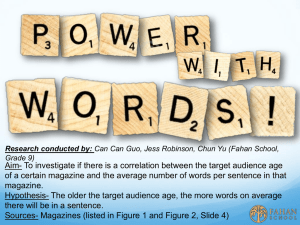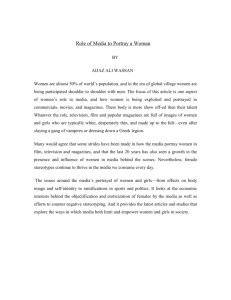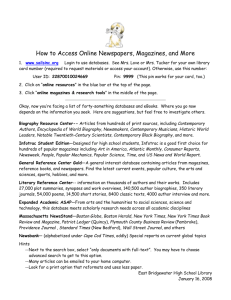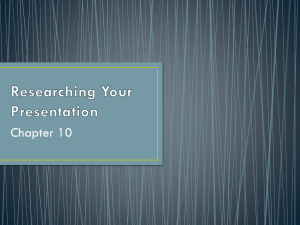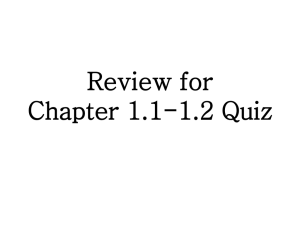HighBrow_lowbrow
advertisement
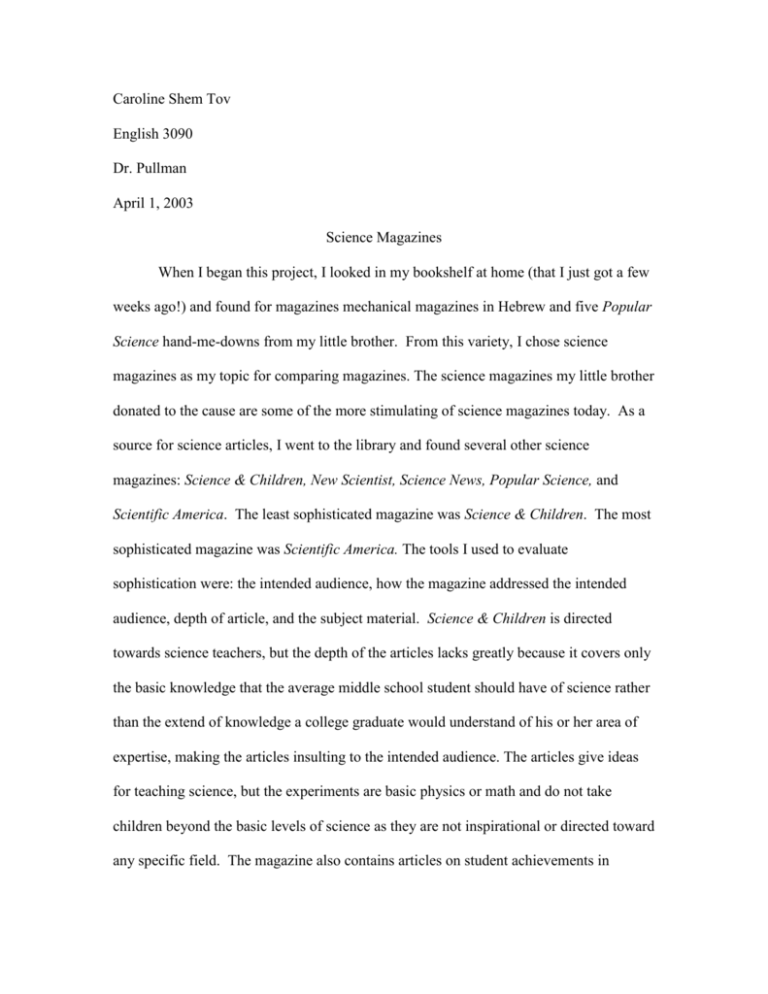
Caroline Shem Tov English 3090 Dr. Pullman April 1, 2003 Science Magazines When I began this project, I looked in my bookshelf at home (that I just got a few weeks ago!) and found for magazines mechanical magazines in Hebrew and five Popular Science hand-me-downs from my little brother. From this variety, I chose science magazines as my topic for comparing magazines. The science magazines my little brother donated to the cause are some of the more stimulating of science magazines today. As a source for science articles, I went to the library and found several other science magazines: Science & Children, New Scientist, Science News, Popular Science, and Scientific America. The least sophisticated magazine was Science & Children. The most sophisticated magazine was Scientific America. The tools I used to evaluate sophistication were: the intended audience, how the magazine addressed the intended audience, depth of article, and the subject material. Science & Children is directed towards science teachers, but the depth of the articles lacks greatly because it covers only the basic knowledge that the average middle school student should have of science rather than the extend of knowledge a college graduate would understand of his or her area of expertise, making the articles insulting to the intended audience. The articles give ideas for teaching science, but the experiments are basic physics or math and do not take children beyond the basic levels of science as they are not inspirational or directed toward any specific field. The magazine also contains articles on student achievements in science and young inventors. This should be given to the student rather than the teacher. It is not a scholarly work although it is directed toward scholars. The New Scientist contains science experiments that children should be able to mimic and it is geared toward its audience. Science News is directed toward a young audience and is clear to understand. It simplifies explanations and stories so that they are suitable for a younger audience. The content is generally focused on inventions and discoveries made in genetics and robotics. Popular Science is precisely what the title implies: popular fields in science. Its articles are comprehendible by a younger audience because the articles are clear and very descriptive. The many topics deal with racecars, submarines, crime analysis, high-tech airplanes, and futuristic concepts. In my opinion, this subject material is not completely sophisticated because it deals with the new trends rather than old, classic sciences. The Scientific America contained clear articles whose topics range from astronomy, insects, findings in biology, geology, physics, chemistry, and health care. This magazine focuses more on discoveries than inventions. I looked at two articles that were both about astronomy, one from Science & Children and the other from Scientific America. The article from Science & Children’s October 2002 edition entitled “Evening Skies” by D. David Batch is very short; it has less than one page of text and the remainder of the two pages is devoted to pictures. The article does not explain the workings of the sky. It simply provides a sky map and what times the constellations listed should be visible. It does not provide explanation and does not go into depth or detail and is, therefore, boring and applies only to people who need no education of astronomy: “The planet Saturn is plotted for mid-November 2002. At chart time, nine objects of first magnitude or brighter are visible. In order of brightness they are Saturn, Vega, Canella…In addition to stars, other objects that should be visible to the naked eye are labeled on the map…1” Clearly the author is emphasizing the map rather than the night sky and the field of Astronomy. The article becomes more of an advertisement for the calendar on the next page than a source for knowledge. The article in Scientific America’s November 2002 edition, entitled “When Stars Collide” by Michael Shara, consists of two full pages of written text and three pages of descriptive pictures. The subject of the article discusses the theory of impact between stars and provides charts that display outcomes of the impacts from different types of stellar bodies such as black holes, white dwarfs, main sequence (our sun), and super giants. There are sequenced pictures that show how the stars change through impact. Shara specifies that it is only a theory, but also provides supporting proofs for the theory. He lists other scientists who have been doing work in the field and gives credit to other sources. He assumes that the reader understands basic laws of physics by relying upon the laws to defend the theory rather than providing an experiment to tests the physical sciences, “When the colliding stars are of the same type, density and size, a very different sequence of events occurs. The case of two unlike stars was first simulated in the early 1970’s by Alastair G. W. Cameron and Frederick G. P. Seidl of the NASA Goddard Institute for Space Studies. As the initially spherical stars increasingly overlap, they compress and distort each other into half-moon shapes. Temperatures and densities never climb high enough to ignite disruptive thermonuclear burning. As a few percent of the total mass squirts out perpendicular to the direction of stellar motion, the rest mixes together. Within an hour, the two stars have fused into one.2” Shara states several times 1 2 Science & Children: October 2002, D. David Batch, 56. Scientific America: November 2002, “When Stars Collide,” Michael Shara, 49. throughout the article that it has never been witnessed, but that it is still a theory. The article refers to other previous works done in the field. In all, the low brow, piece from Science & Children is lowbrow because it does not provoke or inspire the mind of the audience, the teacher. The writing is more suitable for an audience of fifth graders than their teachers. The highbrow piece was not too complex, but it did require a basic understanding of the field. It did not use words that one must look up in a dictionary to understand, but it did use words that related only to that specific field of science along with providing scholarly sources that one could use to go into greater depth on the subject. The most beneficial part of this project is that it has opened my mind to the idea of magazines in the classroom. I intend to teach English and history, but I can use magazines to enhance the students’ fields of knowledge. Not every student likes novels, and there are thousands of magazines out there that students can find engaging. If I were to teach science, I would provide the students with a classroom “library” of magazines articles and have them complete an article report on specific topics. It would even be easy to keep a glossary of articles by entering the subject material in a database monthly. Even though I will not become a science teacher, I could still have my students to book reports on the magazine articles. I could coordinate it with the science teacher, however, so the students find a link between the material and their projects in other classes and have less busy work. I know that not all students like science, but everyone has an interest somewhere as it relates to the world around and the magazines are more in depth and easier at times to understand than the text books. In addition, I could include travel magazines for the students who have a love for other places and that could open a unit on children writing travel brochures and articles about far off countries or family members who live far away. This way, I could get the students to learn to write while stimulating their minds. Too many times, teachers give their students assignments that they hate because they don’t have any interest in the subject, but by letting the students choose an interesting topic in science, I might be able to get a better writing sample than by forcing the children to write about Thomas Edison and his love life. Children are inquisitive by nature, longing to know how things work. When someone takes away the question, the only thing that is left to write about is irrelevant history. Low Brow: Susan Myers of Wichita, Kansas has begun a new unit in her sixth grade science class. The students whet out and found bugs within their neighborhood. They looked under rocks, in trees, in leaves and grass, in there garages, and under their beds and came back to the classroom with their collection. The project was to find out what kind of insects lived around the children every day. The students each brought in five bugs (dead or alive) and in groups of four the children examined the insects with magnified glasses. The counted the legs, noted wings, body structure such as the abdomen and thorax and used the simple catalog to give the kingdom and phylum of the creatures. The children put spiders, ticks, and fleas in their category, ants, and other six-legged creatures together. They had a wonderful time and learned that bugs only live under beds when you leave food or dirty socks under it. High Brow Earthquakes shock our world. They shake down skyscrapers, tear down walls, uproot trees, make rubble of historical sites, and create vast chasms that stretch miles below the earth’s surface. The credit of creating earthquakes and volcanoes is usually given to the flow of magma between the lithosphere and the athenosphere (lower crust and upper mantle), but not all credit of these earthshaking phenomena should be given to the internal structures of the earth. Beyond the layers of the earth mixed among the troposphere, stratosphere, o-zone, there exists a protective layer known as the magnetosphere. It is this sphere that is most influenced by the movement of the planets, sun and moon. As people become lunatics when the moon is full or wane, the earth tremors as a result of tensions placed or released on the magnetosphere. Earthquakes are reactions to the earth relaxing after it has been pulled to one direction. As the bones in the back move when doing heavy work, resulting in a back ache, then the pain goes away when the muscles relax, the athenosphere tightens up in areas and when the stress is removed the athenosphere relaxes, causing an earthquake. Twenty-seven percent of the earth’s quakes occur within three degrees of a forty-five degree angle caused by the sun and moon to the earth. So next time you hear about an earthquake, check out if the moon is full, new, or halfway in-between.
